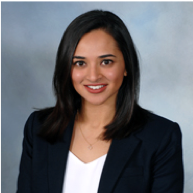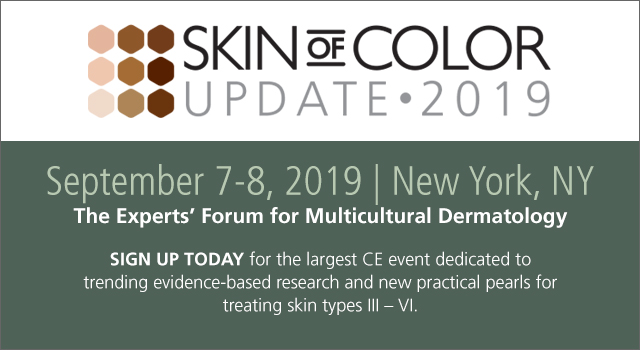Brianna Olamiju, Next Steps Correspondent, interviewed Toral S. Vaidya, Medical Student at the University of Cincinnati College of Medicine, to dig deeper on her research study titled “Socioeconomic and Geographic Barriers to Dermatology Care in Urban and Rural U.S. Populations” recently published in theJournal of the American Academy of Dermatology and presented at the Skin of Color Seminar Series (now Skin of Color Update) in May 2018.
In what ways did this topic originally peak your interest?
Before medical school, I pursued a master’s of public health and developed keen interest in population health. As an aspiring dermatologist, I believe it’s imperative to understand the socioeconomic and geographic barriers my patients face. I hope to use this knowledge to develop interventions to minimize the effects of this provider maldistribution.
What are the implications of delayed access to care by dermatologists for specific groups of people?
I conducted a study that examined the distribution of dermatologists in the context of socioeconomic status, rurality, and race. My study found that counties with larger populations and in urban areas not only have more dermatologists but have a higher dermatologist: population ratio. In addition, counties with higher poverty rates have a lower dermatologist: population ratio, and counties with higher median incomes have a higher dermatologist: population ratio. The association between dermatologist distribution and presence of underrepresented minorities is the most concerning; African American, Latin American, and Native American majorities had significantly fewer dermatologists than average, and those Native American majorities had 0 total dermatologists.
Rural and frontier areas have very little meaningful access to expert dermatology care; only 1.5-10% of dermatologists practice in rural areas [1]. Approximately 28% of the total US population lives in geographic areas that are underserved by practicing dermatologists [2]. Overall, 40% of dermatologists practice in the 100 densest areas of the country [6]. This maldistribution of dermatologic care may cause some patients to postpone or forgo specialty care, which may lead to treatment delays and disease progression. In addition, the average wait time for new and established patients in these rural areas was found to be 4.5 weeks and 3.1 weeks, respectively, which makes it difficult for a patient to be seen quickly for an acute dermatological complaint [3].
Increased distance is generally viewed as a barrier to screening, diagnosis, and treatment as well [4]. Studies have found that the farther that patients travel to reach their diagnosing providers, the more advanced their stage at melanoma diagnosis is likely to be [4]. In dermatologic diseases like melanoma, these delays can have significant impacts on mortality.
In addition, previous studies suggest preferential access and greater use of specialist services for patients in higher socioeconomic settings [5]. Outcomes for dermatological diseases, such as melanoma and non-melanoma skin cancer, are poorer for people of low socioeconomic status [4]. This decreased access to care may contribute to poorer outcomes among patients of lower socioeconomic status.
What suggestions do you propose for helping to merge these racial and socioeconomic disparities?
Patients living in rural areas, patients in lower socioeconomic strata and minority patients clearly do not have an acceptable level of access to dermatologists.
Part of the problem may be that we are not training enough minorities in dermatology. It is well-known that minority physicians are more likely to care for patients of their own race or ethnic group, practice in underserved areas, and provide care to poor patients – sadly 3% of the US dermatology workforce is African American and 4.1% is Latino. Initiatives from the American Board of Dermatology and other dermatology organizations to train more dermatologists from these backgrounds could be a good starting point.
In addition, patients who grew up in rural areas are most likely to practice in those areas; this trend has been seen in Michigan State University College of Human Medicine Rural Physician Program. This program selects students with experience in rural areas and/or who are interested in practicing medicine in rural areas, and exposes them to a wide variety of rural clinical opportunities during medical school. These students are significantly more likely to practice in rural regions than their classmates who were not in the program. Methods to incentivize practice in rural, poor, and high minority areas, such as loan forgiveness, should also be considered.
The development and progress of teledermatology has helped provide dermatology care to underserved areas, and the American Academy of Dermatology should be commended for its AccessDerm initiative. Continued efforts to study and optimize this modality, and to get coverage by insurance carriers will certainly help those who could not otherwise receive in-person dermatologic care.
References:
- Resneck J Jr, Kimball AB. The dermatology workforce. J Am Acad Dermatol 2004;50:50-4.
- Suneja T, Smith ED, Chen GJ, Zipperstein KJ, Fleischer AB Jr, Feldman SR. Waiting times to see a dermatologist are perceived as too long by dermatologists: implications for the dermatology workforce. Arch Dermatol 2001;137:1303-7.
- Uhlenhake E, Brodell R, Mostow E. The dermatology work force: a focus on urban versus rural wait times. J Am Acad Dermatol. 2009 Jul;61(1):17-22. doi: 10.1016/j.jaad.2008.09.008. Epub 2009 May 7
- Stitzenberg KB, Thomas NE, Dalton K, et al. Distance to Diagnosing Provider as a Measure of Access for Patients With Melanoma. Archives of dermatology. 2007;143(8):991-998. doi:10.1001/archderm.143.8.991.
- Haider A, Mamdani M, Shaw JC, Alter DA, Shear NH. Socioeconomic status influences care of patients with acne in Ontario, Canada. J Am Acad Dermatol. 2006 Feb;54(2):331-5. PubMed PMID: 16443069.
About Toral S. Vaidya, MPH



